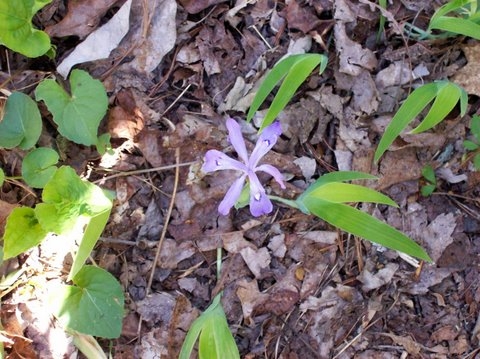Iris cristata – Dwarf Crested Iris
Iris cristata (EYE-ris kris-TAH-ta)
Dwarf Crested Iris
A spring interest blue flower, the Dwarf Crested Iris is one of the few Iris species that is native to the United States. Its rhizomatous habit helps it to propagate with vigor in woodland settings, creating a vivid carpet of blue flowers amongst the lush greenery of the shade garden. This short early blooming perennial works best in shaded areas, but will tolerate a sunny location with adequate moisture.
You can combine Iris cristata with plants like Heuchera villosa, Aquilegia canadensis, or Helleborus. It also gets along well with Phlox divaricata and Tiarella cordifolia. Woodland sedges like Carex plantaginea and native ferns like Athyrium filix-femina or Polystichum acrostichoides make good foliage companions.

Wildflowers along Leatherwood Loop Trail, Leatherwood Ford Area, Big South Fork National River and Recreation Area , Oneida, TN
If you prefer a less vigorous cultivar, choose Iris cristata ‘Alba’, which has white flowers with a yellow crest.
Origin:
Iris – Referring to the rainbow color of the flowers, derived from the Greek goddess of rainbows, Iris.
cristata – With tassle like tips or crested.
Family – Iridaceae
Nativity – Maryland to Georgia west to Missouri
Hardiness – USDA Zones 4-9
Description:
Form – Small stature spring blooming perennial reaching 6″ and 12″ wide. Stolons creep along the surface of the soil creating large clumps.
Foliage – 6-8 basal leaves that are divided into 2-3 proximal and 5-6 distal. The proximal leaves are sickle-shaped while the distal are sword-like. After flowering, the leaves elongate, hiding any seed pods that remain.
Flower – The fragrant lavender to blue flowers appear between April and May on short stalks. Dwarf Crested Iris has two pairs of petals and 3 large sepals. The sepals are where the yellow crests appear, surrounded by a purple or navy blue ring.
Culture:
Light – Dappled to heavy shade / Will tolerate sun with enough moisture
Soil – Prefers calcareous, well drained, humus-rich soil.
Propagation – Division in early autumn or by seed.
Problems – Slugs and snails.
Comments – Iris lacustris is the other native crested Iris.
♥Source your Dwarf Crested Iris from Newmoon Nurseries.




